Goal
In this tutorial you will learn how to:
- Use the OpenCV function cv::filter2D in order to perform some laplacian filtering for image sharpening
- Use the OpenCV function cv::distanceTransform in order to obtain the derived representation of a binary image, where the value of each pixel is replaced by its distance to the nearest background pixel
- Use the OpenCV function cv::watershed in order to isolate objects in the image from the background
Theory
Code
This tutorial code's is shown lines below. You can also download it from here.
#include <iostream>
int main()
{
return -1;
for(
int x = 0; x < src.
rows; x++ ) {
for(
int y = 0; y < src.
cols; y++ ) {
}
}
}
imshow(
"Black Background Image", src);
1, 1, 1,
1, -8, 1,
1, 1, 1);
Mat imgResult = sharp - imgLaplacian;
imgLaplacian.convertTo(imgLaplacian,
CV_8UC3);
imshow(
"New Sharped Image", imgResult );
src = imgResult;
imshow(
"Distance Transform Image", dist);
vector<vector<Point> > contours;
for (size_t i = 0; i < contours.size(); i++)
drawContours(markers, contours, static_cast<int>(i), Scalar::all(static_cast<int>(i)+1), -1);
imshow(
"Markers", markers*10000);
vector<Vec3b> colors;
for (size_t i = 0; i < contours.size(); i++)
{
}
for (
int i = 0; i < markers.
rows; i++)
{
for (
int j = 0; j < markers.
cols; j++)
{
if (index > 0 && index <= static_cast<int>(contours.size()))
dst.
at<
Vec3b>(i,j) = colors[index-1];
else
}
}
return 0;
}
Explanation / Result
- Load the source image and check if it is loaded without any problem, then show it:
Mat src =
imread(
"../data/cards.png");
if (!src.data)
return -1;
- Then if we have an image with a white background, it is good to transform it to black. This will help us to discriminate the foreground objects easier when we will apply the Distance Transform:
for( int x = 0; x < src.rows; x++ ) {
for(
int y = 0; y < src.
cols; y++ ) {
if ( src.at<
Vec3b>(x, y) ==
Vec3b(255,255,255) ) {
src.at<
Vec3b>(x, y)[0] = 0;
src.at<
Vec3b>(x, y)[1] = 0;
src.at<
Vec3b>(x, y)[2] = 0;
}
}
}
imshow(
"Black Background Image", src);
- Afterwards we will sharpen our image in order to acute the edges of the foreground objects. We will apply a laplacian filter with a quite strong filter (an approximation of second derivative):
Mat kernel = (Mat_<float>(3,3) <<
1, 1, 1,
1, -8, 1,
1, 1, 1);
Mat imgLaplacian;
Mat sharp = src;
Mat imgResult = sharp - imgLaplacian;
imgLaplacian.convertTo(imgLaplacian,
CV_8UC3);
imshow(
"New Sharped Image", imgResult );
- Now we transform our new sharpened source image to a grayscale and a binary one, respectively:
- We are ready now to apply the Distance Transform on the binary image. Moreover, we normalize the output image in order to be able visualize and threshold the result:
Mat dist;
imshow(
"Distance Transform Image", dist);
- We threshold the dist image and then perform some morphology operation (i.e. dilation) in order to extract the peaks from the above image:
Mat kernel1 = Mat::ones(3, 3,
CV_8UC1);
- From each blob then we create a seed/marker for the watershed algorithm with the help of the cv::findContours function:
Mat dist_8u;
vector<vector<Point> > contours;
Mat markers = Mat::zeros(dist.size(),
CV_32SC1);
for (size_t i = 0; i < contours.size(); i++)
drawContours(markers, contours, static_cast<int>(i), Scalar::all(static_cast<int>(i)+1), -1);
imshow(
"Markers", markers*10000);
- Finally, we can apply the watershed algorithm, and visualize the result:
Mat mark = Mat::zeros(markers.size(),
CV_8UC1);
vector<Vec3b> colors;
for (size_t i = 0; i < contours.size(); i++)
{
}
Mat dst = Mat::zeros(markers.size(),
CV_8UC3);
for (int i = 0; i < markers.rows; i++)
{
for (int j = 0; j < markers.cols; j++)
{
int index = markers.at<
int>(i,j);
if (index > 0 && index <= static_cast<int>(contours.size()))
dst.at<
Vec3b>(i,j) = colors[index-1];
else
}
}


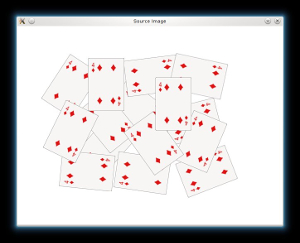

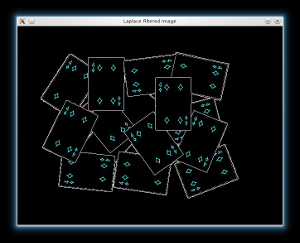
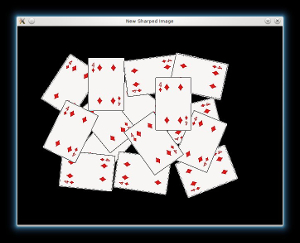

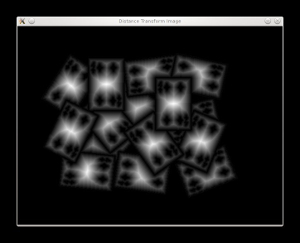
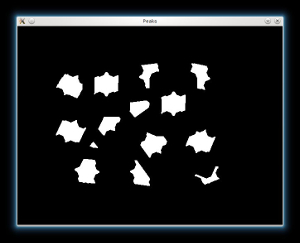
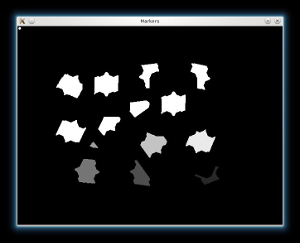

 1.8.12
1.8.12